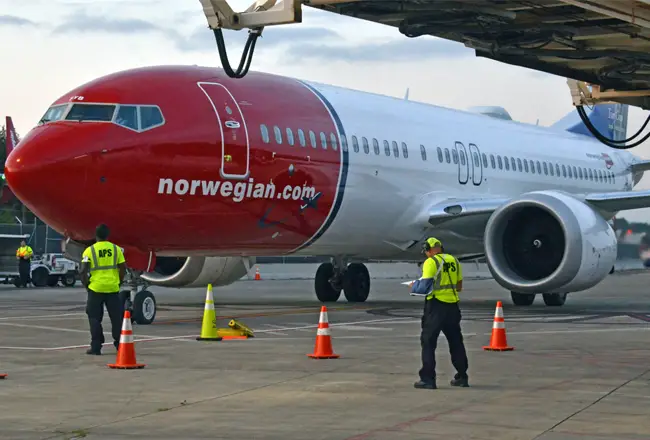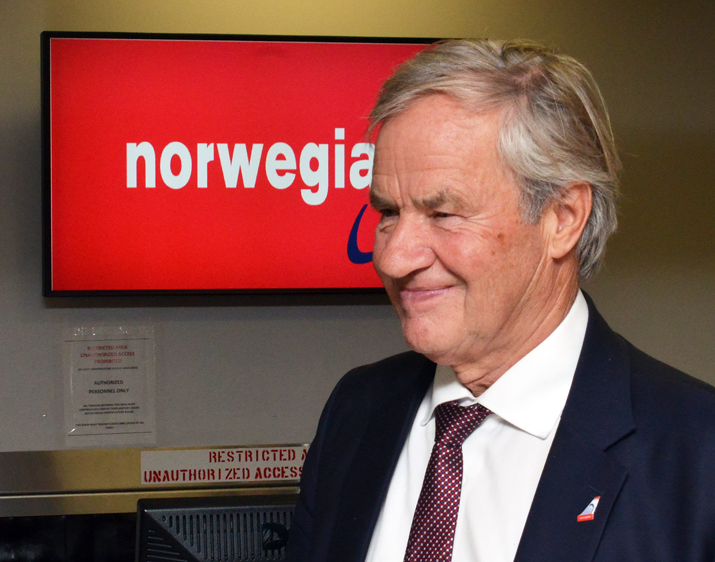Norwegian Air ”“ New York Stewart International Airport”™s only international carrier ”“ is ending direct service to Edinburgh, Scotland, in the spring and flights to Belfast, Ireland, at the end of October.

“Following a comprehensive review of our services to and from Edinburgh, Norwegian has decided to withdraw its routes from Newburgh, New York, and Providence, Rhode Island, as well as from several European destinations,” Anders Lindström, director of communications for the airline”™s U.S. operations, said in an email.
Flights to Dublin will remain twice-daily, Lindström said. Flights to Shannon, Ireland, will also continue.
A spokesperson for Belfast International Airport accused the airline of “moronically channeling much greater levels of Northern Ireland passengers onto Dublin flights.”
“It is an unsustainable situation that two million people in our catchment area should be left with no option but to undertake lengthy and unnecessary journeys to Dublin in order to fly across the Atlantic,” the spokesperson told the Belfast Telegraph.
According to The Scotsman newspaper, Norwegian is ending two of its five other routes from Edinburgh Airport to Barcelona, Spain, and the Canary Island of Tenerife. The flights will end in March, cutting Norwegian”™s routes out of Edinburgh from six to three.
The Scotsman reported that the airline is also closing its base at Edinburgh Airport.
“Our affordable U.S. flights were launched with the prospect of a reduction in air passenger taxes that was unfortunately postponed by the Scottish government. This has forced us to fully withdraw our transatlantic services to and from Edinburgh, as it would not be a sustainable operation,” Lindström said.
Two years ago, Scotland”™s major airports had asked First Minister and leader of the Scottish National Party Nicola Sturgeon in a joint letter to cut air passenger duty (APD) by 50 percent in April 2018.
Independent research commissioned by Edinburgh Airport found that a “50 percent cut in APD would generate an additional 4,000 jobs and bolster Scotland”™s economy by an additional 1 billion pounds.”
Amanda McMillan, managing director of Glasgow Airport, wrote, “The longer this regressive tax is in place, the longer it will damage Scotland”™s economy, our tourism potential and our ability to prosper as a nation. This is something which has also been recognized by our business and tourism partners.”
It has been reported that the Scottish National Party has failed to garner support for cutting the APD.
Liz Cameron, chief executive of the Scottish Chambers of Commerce, stated in the letter that the “air passenger duty is a tax on Scotland”™s connectivity and a tax on international trade. The U.K. is currently one of the few European countries to apply a tax on air travel, and it does so at a very high rate. Devolution of APD, therefore, gives Scotland the opportunity to boost our competitiveness by decisively reducing the impact of this tax by 50 percent. Doing so would make Scotland an even more attractive place to do business, and the sooner this tax is cut, the better.”
The last flight from Stewart to Edinburgh is scheduled to depart March 29.


In an interview with USA Today earlier in September, Norwegian CEO Bjørn Kjos said flights from Newburgh and Providence remain important.
“You have to try,” he said, adding that he”™s happy with the current lineup of transatlantic offerings. “The routes that we are flying now work quite fine.”
“I think we will fly more into Newburgh,” Kjos told the newspaper, though he did not offer specifics. “Newburgh is doing very well.”
Since Norwegian began flights at Stewart in June 2017, passenger count more than doubled at the airport. The increase also prompted the Port Authority of New York and New Jersey to rebrand the airport as New York Stewart International Airport to make it easier for international travelers to easily identify its geographical location.
The Port Authority also approved a $30 million expansion of the airport that includes construction of a permanent U.S. Customs and Border Protection inspection area.



















